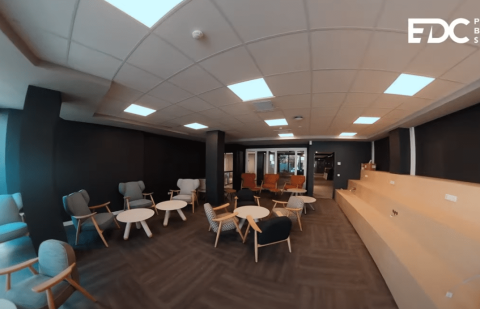
The 5 most popular HR software packages
People are undoubtedly the most valuable asset of any company, which is why Human Resources management software has become an increasingly essential tool. HR software improves the reliability of HR processes, boosts productivity and puts people back at the heart of the organization. But each software has its own specific features, so how do you choose ?
Get to know them better and get a head start before discovering our Master in Human Resources and Change Management.
What is HR software and what is it used for ?
Why use HR software ?
The "Human Resources" function is essentially administrative, and forms part of the company's support functions, in the same way as communications or legal affairs, for example. It is, however, essential, as it organizes the company's human resources (jobs) to ensure its smooth running. It must therefore ensure that individual performance and team organization are aligned with the company's performance objectives.
The first Enterprise Resource Planning (ERP) system was introduced in 1979, offering users the possibility of combining company data in real time. The first HR software proper appeared in 1987: Oracle's PeopleSoft package. From the late 1990s onwards, software manufacturers such as Softscape began offering cloud-hosted HR services to make this technology more accessible to remote teams.
Overall, HR software helps an organization's human resources department automate repetitive manual tasks, organize employee information and create data-driven reports. For example, it supports the storage of employee data, payroll management, recruitment, benefits tracking and management (bonuses and rewards), time and leave management, employee performance management and the tracking of skills and training records. All this is done electronically, eliminating the need for paper documents.
HR software generally takes the form of a suite of modules, each designed for a specific HR process. The overall HR platform is called a "human resources management system" (HRMS) or "human resources information system" (HRIS), and takes care of the administrative side of HR (payroll, expense reports, leave and absences, planning...). It often incorporates a "human capital management" (HCM) module focused on career development management (recruitment, training, skills assessment, etc.).
Functionalities included
Human resources (HR) management software offers key functionalities that meet the essential needs of companies of all sizes. Here are the main ones included in most HR solutions:
- Employee administrative management: centralized data (contracts, contact details, job descriptions), absence and leave tracking, and automated document generation.
- Time and activity tracking (TAM): time and attendance management, clocking in and out, and activity reports for greater visibility on productivity.
- Recruitment and onboarding: publication of job offers, application tracking, and simplified integration of new employees.
- Payroll management: synchronize data to calculate salaries, manage social security contributions, and issue pay slips.
- Training and skills development: track training plans, certifications, and assess development needs.
- Appraisals and performance management: define objectives, track annual appraisals and provide regular feedback.
- Compliance and reporting: generate regulatory reports and dashboards to meet legal obligations and analyze HR data.
These functions enable optimized management of human resources, promoting productivity and employee well-being.
What are the advantages of human resources management software ?
As with most business software, the main benefit of HR software is to automate tasks that would otherwise have to be handled manually. However, HR applications bring many other benefits to companies:
Electronic invoicing offers many advantages:
Efficiency and productivity
HR software facilitates information gathering and improves process efficiency. It allows all data to be centralized in a single interface, facilitating collaboration between the various HR department staff (managers, assistants, payroll managers, etc.), who can then make decisions more rapidly.
Employee loyalty
Talent management, from recruitment interviews through to training programs, helps to improve the life and well-being of employees within the company, and thus to build their loyalty over the long term.
Forecasting requirements
HR data analysis enables us to anticipate recruitment needs and plan appropriate training programs to ensure skills development within the company.
Cost savings
Managing payroll and benefits costs is a top priority for all companies. Human resources management systems make it possible to control financial costs (e.g. dematerialization of pay slips, leave management) and more easily identify opportunities to reduce expenditure (e.g. by optimizing recruitment).
Error reduction
Payroll automation eliminates the risk of errors in manual data entry, and the payment of tax penalties in the event of delays or miscalculations.
Strengthening strategic issues
The lightening of administrative tasks due to task automation allows HR managers to focus on more strategic activities in the long term (skills development, optimizing the overall work experience, etc.).
Regulatory compliance
Specific compliance areas where HR solutions can play an important role include RGPD compliance (particularly with regard to data security and data retention periods), right-to-work controls and health and safety training compliance.
The most popular HR software
There are several hundred HR software packages available in France and around the world. Most are general-purpose, covering all human resources issues. Others are specialized, focusing for example on payroll management, scheduling or recruitment processes. Finally, there are modular software packages that allow you to choose only the modules you need. No software is fundamentally better than any other, but some are more successful than others:
Software no. 1: ADP
ADP software is first and foremost an automated payroll manager for small, medium and large companies. It can also manage all time and activity management, resource planning and budgeting needs within a single system.
Software no. 2: Kelio
Kelio was originally designed specifically to track employee attendance, absence and activity data. It offers many other administrative and talent management functionalities, and can also manage access control and secure premises (access supervision, visitor reception, meeting room reservations, etc.).
Software no. 3 : Cegid
Cegid is a French accounting software package specializing in payroll and commercial management for small businesses and SMEs. Easy to use, it is also scalable, adapting to the needs of each business sector.
Software no. 4 : Combo
The HR software package Combo is more specifically dedicated to personnel management, especially for field teams. It lets you create and organize schedules in just a few clicks, measure productivity and record hours of attendance for payroll purposes.
Software no. 5 : Lucca
Lucca is a solution that integrates with your existing information system (payment, accounting, traditional ERP, etc.) to offer you only the HR modules that interest you. Simple and intuitive, this HR software is designed to make life easier for users and boost your productivity.
In human resources, well-being at work is an essential factor. Set up a Quality of Life at Work (QWL) approach involves assessing employee expectations, defining precise objectives and adopting tools such as satisfaction surveys and dashboards. Encouraging work-life balance, valuing employees' contributions and creating a positive working environment are essential to improving the well-being and overall performance of teams.
Moreover, change management is based on six essential steps: analyzing the current situation to identify needs, involving stakeholders in a shared vision, drawing up a clear action plan, supporting teams in adopting new practices, monitoring progress with precise indicators and evaluating results to adjust if necessary. Successful corporate change management requires a structured, participative approach that encourages buy-in and sustainability.
OUR PROGRAMS
THE LATEST NEWS
Your campus at La Défense !
29 09 2021 | Our news
Watch a video of your new campus in the heart of La Défense
Le Parisien 2021 ranking of business schools with Master's degrees
19 05 2021 | Competition I Student I Our news
EDC Paris Business School takes 6th place in the ranking of "Ecoles post-bac".

